100 weeks of Scotland: Hydro-electric power
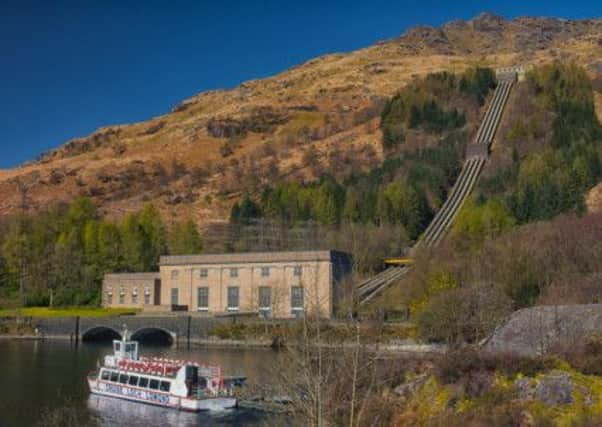

Week 77
As I drive up the western shore of Loch Lomond I am once again surprised at just how stunningly beautiful it is. The first boats are venturing out onto the glassy water and the day ahead promises to be warm. Perfect weather for the people who will flock to the loch this Easter weekend. Apart from a brief stopover, I am just passing it by.
Colossal works of engineering
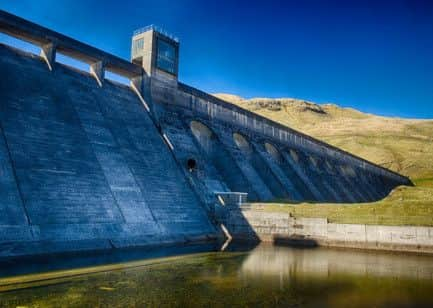

Today I am planning to photograph some of the incredible Hydro Electric infrastructure that delivers so much of the electrical power to Scotland. I have always been fascinated by these colossal works of engineering and to me they form an essential part of the scenery of Scotland. The architecture of the dams and the power stations they feed seems to blend in perfectly with the landscape and, almost always, are beautiful buildings in their own right. Was there some form of agreement in the 1950s, when a lot of the infrastructure was built, to create buildings sympathetic to the countryside? Or am I merely looking at it after a gap of 60-odd years unaware of the massive upheaval, and environmental damage, these huge engineering projects must have caused at the time? Either way, the buildings themselves are wonderful, and I love them.
Advertisement
Hide AdAdvertisement
Hide AdMy first stop is on the bonnie bonnie banks of Loch Lomond at the generating station for the Loch Sloy dam, at Inveruglas. The dam at Loch Sloy, nestled high in the mountains above was built to provide power to the Glasgow area and work began in 1945. Many German prisoners-of-war worked on the project, including a detachment of ex-SS soldiers who did so little work, and who upset the other German prisoners so much that they were sent back to their camps.
Cruachan
I head next to Cruachan, where the inside of the mountain has been hollowed out to house the massive turbines powered by the dam above. From the Cruachan Visitor centre it is a short 200m hop across Loch Awe by boat to the area where I want to photograph the dam from. However, there never has been a boat here and the alternative is a 30 mile round trip. The weather is wonderful and the scenery is incredible so it is no chore at all. Before long, I am on the other shore of the Loch, looking north across the water at the dam high in the mountains above. I park the car and spot a little hill not too far away across a nice looking meadow where I think I will get the best shot. Feeling smug that my planning has worked so well I grab my camera bag and tripod and set off.
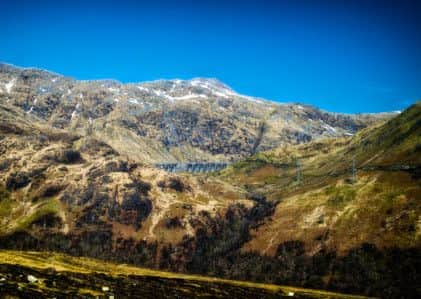

Ten minutes later and I am, literally, up to my thighs in a bog. The lovely meadow that looked so enticing from the car is anything but. Nearby my dog is apoplectic with pleasure at the great new game her master is playing. I too am apoplectic. Covered in mud, and soaked through, I struggle to the top of the hill and take my photo. I had dried out a little before I headed back where, inevitably, I repeated my mud bath several times. It wasn’t so bad – I hadn’t spotted the rats at this point. (Admittedly I am pretty sure they were water voles, but there were LOTS of them). Sometimes the countryside can be wonderful and sometimes it can be a real pain in the arse. My arse. My soaking wet and muddy arse.
A convergence
I head to my next location and not even the drive through some of the most incredible countryside you could wish for was lightening my mood. Then, as I approach Dalmally, a train appears suddenly at my side and for about two miles perfectly matches my speed as the tracks and the road converge and carry on together only a few feet apart. Quite why this should fill me full of joy I have no idea, but the clatter of the train to my right, and the snow capped peaks to my left seemed magical. I wave at the train - you never know, somebody might wave back.
Lawers Dam
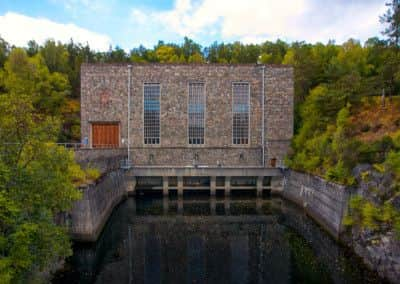

Before long I am at the spectacular Lawers Dam at Lochan na Lairige. This incredible buttress dam took 5 years to build in the early 1950s. From here the water descends 415 metres to Finlarig Power Station on the banks of Loch Tay, the largest drop of any Scottish Hydro-electric scheme. The narrow road I have taken to get here, and that winds on through these mountains north to Glen Lyon is breathtaking and is well worth travelling. I follow it to Bridge of Balgie and then head west along the river to the Lubreoch dam at Loch Lyon. I am at the end of the road now. I can go no further west so I turn and leave this remote and wonderful area to the birds and the sheep.
As I head home I stop at Tummel Bridge to photograph two turbine houses on either side of the river. Looking for all the world like exclusive Highland hotels these two buildings once again leave me marvelling at the beauty of their architecture, and thanking, for the umpteenth time, the men and women who built them.
• Alan McCredie began the ‘100 weeks of Scotland’ website in October last year, and it will conclude in Autumn 2014. McCredie’s goal is to chronicle two years of Scottish life in the run-up to the independence referendum.
Alan says ‘one hundred weeks...’ is intended to show all sides of the country over the next two years. On the site, he says: “Whatever the result of the vote Scotland will be a different country afterward. These images will show a snapshot of the country in the run up to the referendum.
Advertisement
Hide AdAdvertisement
Hide Ad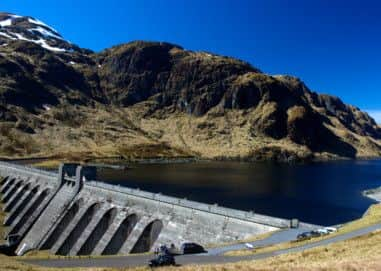

“The photos will be of all aspects of Scottish culture - politics, art, social issues, sport and anything else that catches the eye.”
Follow the project at www.100weeksofscotland.com. You can also follow Alan on Twitter @alanmccredie.